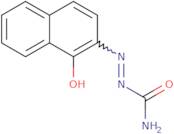Naftazone
CAS: 15687-37-3
Rif. 3D-QAA68737
| 1mg | Fuori produzione | ||
| 5mg | Fuori produzione | ||
| 10mg | Fuori produzione | ||
| 25mg | Fuori produzione | ||
| 50mg | Fuori produzione |
Informazioni sul prodotto
- (2E)-naphthalene-1,2-dione 2-semicarbazone
- 1,2-Naphthaquinone 2-semicarbazone
- 1,2-Naphthoquinone 2-semicarbazone
- 2-(1-Oxo-2(1H)-naphthalenylidene)hydrazinecarboxamide
- 2-Semicarbazono-1(2H)-naphthalinon
- Etioven
- Haemostop
- Haemostop Injection
- Hydrazinecarboxamide, 2-(1-oxo-2(1H)-naphthalenylidene)-
- Karbinon
- Vedi altri sinonimi
- Karbinone
- Mediaven
- Mediavene
- Naftazon
- Naftazona
- Naftazona [INN-Spanish]
- Naftazone [INN:BAN:DCF]
- Naftazonum
- Naftazonum [INN-Latin]
- Naphthalene-1,2-Dione 2-Semicarbazone
- Unii-15B0523P5L
- [(1-Oxo-1,2-dihydronaphthalen-2-ylidene)amino]urea
Naftazone is a potent inhibitor of cancer cells that has been found to induce apoptosis, or programmed cell death. It works by inhibiting kinases, which are enzymes that play a key role in the regulation of cell growth and division. Naftazone is a medicinal compound that has been extensively studied for its anticancer properties, and it has shown promising results in preclinical trials. This compound is an analog of a Chinese herbal medicine used traditionally for the treatment of tumors. Naftazone is excreted primarily in urine and has been found to be effective against a wide range of human cancer cells. Its ability to inhibit protein kinase activity makes it an attractive target for the development of new anticancer drugs.





